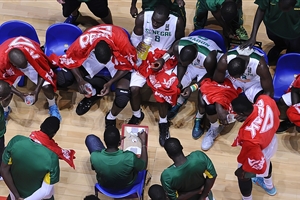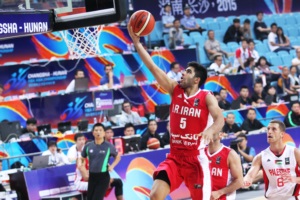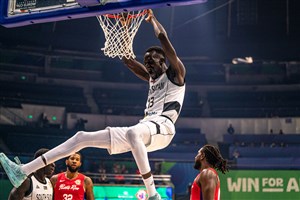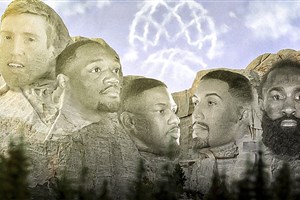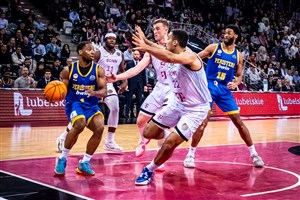
Because it's there - Former USA stalwart Jeff Glasbrenner keeps searching new challenges
CHARLOTTE (Steve Goldberg's Wheel World) - So what's next, I asked Jeff Glasbrenner, twice an IWBF World Champion (1998, 2002) with the USA as well as a three-time Paralympian (2000, '04, '08) for the Americans.
Before we jump to his answer on what lies ahead though, I have to tell you what Glasbrenner, who had just flown halfway around the world to get home to Golden, Colorado, had just accomplished. On May 18 he was in the Himalayas capping a climb to the top of Mt. Everest.

I'm on top of the world, Ma! Former USA wheelchair basketball star Jeff Glasbrenner is hoisted by expedition teammates at the summit of Mt. Everest. Photo courtesy of TeamGlas.com
Yeah, that Everest; the Sir Edmund Hillary/Tenzing Norgay one; the dividing line between Nepal and Tibet.
"I'm pretty stoked about it", he said of the climb, "pretty stoked that I lived."
We agreed that survival should be a high priority in any endeavor but Glasbrenner had cheated death before.
A single below-knee amputee since a near fatal farm accident at age 8, Glasbrenner is now certified as the first American amputee to summit Everest, the tallest mountain on the planet at 29,029 feet (8,848 m).
I wasn't there in person to see him strike a pose on top of the world but I was most definitely there when Jeff had the greatest performance ever in an NWBA championship final, perhaps any final anywhere.
At halftime of the 2004 Championship Division (then D1) final between the Dallas Wheelchair Mavericks and Denver Rolling Nuggets I walked over to the scorer's table to get the boxscore. Looking it over as I turned away, two obvious mistakes jumped out at me.
I turned back to question the scorer, which happened to be current USA Women's head coach Stephanie Wheeler, who at that time was soon to win the first of two Paralympic gold medals as a USA player. Before I could utter a word, she just looked at me with the same bewilderment that must have been obvious on my face and said, "Yeah, I know… right?"
Together we looked over the scorebook to correct the error but sure enough, Jeff Glasbrenner had 31 points and 17 rebounds. And it was only halftime!
He would go on to notch the most awesome yet simultaneously unspectacular 63 point game you'd ever see. With his longest shots coming from the free throw line, he hit 22 of 29 shots (76 percent) while grabbing 26 rebounds. Except for the mundane, no flash, matter-of-fact way in which he did it, it was Stephen Curry crossbred with Bismack Biyombo.
Cool, calm, and oh so efficient, he led the underdog Nuggets from a 10 point halftime deficit to a 110-99 victory over dynastic Dallas.
As surprised as Wheeler and I were - Seriously, we were watching the game; how could we not know this was happening? - Glasbrenner was equally astonished when informed of his totals after the game.
"I was in a zone," he told me then as teammates celebrated around him, a disbelieving look on his face when shown the final box. "I couldn't hear the crowd, I had no idea."
Jeff Glasbrenner of the USA jockeys for position against Canada's Dave Durepos with Patrick Anderson coming to help in the 2008 Beijing Paralympic Games. Photo by Steve Goldberg/SCS Media
Already a bronze medal winner with the USA in Sydney, Jeff had worked hard to become one of the best players in the world. That's what he does. He sets a goal and overachieves it. Thought not an everyday wheelchair user, he mastered the subtleties of making the chair an extension of his body. He could tilt his chair onto two wheels easier than most giving his long arms extra reach.
Prior to Denver, he had gone to Europe to play professionally for CD Ilunion (formerly CD Fundosa ONCE) in Madrid and for Santa Lucia in Rome.
The previous NWBA record, a mere 39 points, was set in 1968 and stood for 36 years. Glasbrenner's 63 may never be eclipsed. Many teams don't score that much.
How much did the record mean to him? “As long as we win, I don't care.”
Jeff Glasbrenner (10) didn't play wheelchair basketball until he was 21 but he made his first national team in 1998, winning a world championship. Photo of China Daily by Steve Goldberg/SCS Media
Because it's there.
When asked in 1923 why he wanted to climb Mount Everest, the British mountaineer George Mallory gave the succinct and simple response, "Because it's there."
Though he had been injured more than a decade before, Glasbrenner didn't know wheelchair basketball was there until he was 21. He chose to attend college at the University of Wisconsin-Whitewater, a little more than a two-hour drive due east from where he grew up in the small farming community of Boscobel, because his sister was there.
After the accident, the self-described "very competitive" Glasbrenner was kept on the sidelines by over-protective doctors and parents as his sister excelled in athletics.
It was kind of hard for me since my sister was the best athlete in the whole school while I was sitting on the sidelines. - Glasbrenner
"I was having problems with my artificial leg and was unable to wear it one day. This guy approached me and said that I should try basketball. I quickly explained to him that I was missing a leg and was unable to run."
The stranger just laughed and said, "I am too."
"I couldn’t believe such a thing existed. As it turned out, my university had a wheelchair basketball team."
As luck would have it, the single amp Samaritan was Troy Sachs, a five-time Paralympian for Australia from 1992 to 2008. So similar to each other in physical ability, Sachs would be a perfect "roll model" for Glasbrenner to emulate.
"After that first day of practice, I was bitten with the basketball bug."
His Whitewater coach for two years, Mike Frogley, now steward of Wheelchair Basketball Canada's National Academy, inspired him to aspire for the American squad. Glasbrenner set his objective to make the national team by 2000.
"With my goal in mind, I began to train eight hours a day, five days a week. I achieved my goal earlier than expected in 1998."
Glasbrenner has always been a “bucket list” sort of athlete — finish one adventure and move on to the next. He has completed 13 marathons and 22 Ironman triathlons. – Denver Post April 17, 2014
Because it's there.
I know that Glasbrenner breathes that concept. He sets an objective and then he goes after it. It doesn't always happen. The lack of a Paralympic gold medal attests to the fact that desire and effort aren't always enough. George Mallory died on his third attempt to scale Everest.
Moving on, he took up triathlon as a challenge after watching the three-peat of pain on TV in 2005 and thought, "I could do that."
It overlapped with the close of his competitive basketball career and the beginning of his mountaineering. To date, he has completed 25 Ironman competitions, not the sprint version in the Olympics and Paralympics but the full Monty which includes a 2.4-mile (3.86 km) swim, a 112-mile (180.25 km) bicycle ride and a marathon 26.2-mile (42.2 km) run.
He's also run over a dozen marathons on their own merit, including twice in Boston. The second one in 2013 took a year to finish as he was at the 25.9 mile mark when the bombs went off.
You don't just go out and climb a mountain. In an admittedly unbalanced analogy, I'll compare it to the basketball team that has a shoot-around at an opponent's court to get used to the conditions. Both serve a purpose but the more life-threatening conditions of razor thin air, pop-up storms and sub-zero temperatures take a bit more time to sort out than the depth perception within an opponent's arena or the bounce of a different court.
The "shoot-around" at Everest lasted more than a month. Glasbrenner's expedition team arrived at their Mount Everest base camp on April 3 and trained as hard as any professional team looking to win a title.
On May 10, the group embarked on their summit climb, finally reaching the top of Everest on May 18.
Did his time and experience on the basketball court help when it came to the "team" dynamics of the Everest assault?
"100 percent," he said without hesitation. "It's very much a team sport and we rely on each other much the same as in basketball."
"There are days when you are going to be the best player on your team and other days when you need help. It's very important to have that camaraderie and sense of purpose to all be together for that one summit or one gold medal."
Specific to Everest, he said, "Seven of us went for the summit and all seven of us made it so that was a gold medal."
Room with a view. Former basketball star Jeff Glasbrenner holds up a different kind of trophy at the top of Grand Teton in 2014. Photo by Will Strathmann courtesy of TeamGlas.com
So what's next, I asked?
With the successful assault on Everest, Glasbrenner is now two down and five to go on his objective of climbing the Seven Summits, the highest mountains on each continent. He previously conquered Aconcagua (22, 841 ft/6962 m) of the Andes mountain range, the highest point outside of Asia, in Argentina near the Chilean border.
But that's long range next. In the short term, now that he's back to the relatively low altitude of the Colorado mountains, Jeff's focus is on family, and laying the positions of doting dad and husband to his oh so supportive wife Elizabeth, daughter Grace, 10 and son Gavin, who's 8.
No surprise there. He's a team player.
Steve Goldberg
FIBA
FIBA's columnists write on a wide range of topics relating to basketball that are of interest to them. The opinions they express are their own and in no way reflect those of FIBA.
FIBA takes no responsibility and gives no guarantees, warranties or representations, implied or otherwise, for the content or accuracy of the content and opinion expressed in the above article.
To help make this column as inclusive as possible, please send any national or international event information, story suggestions, or comments to wheelworldmail@gmail.com.

